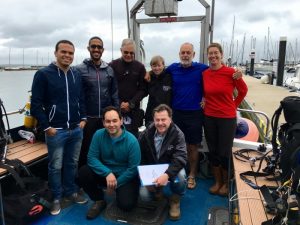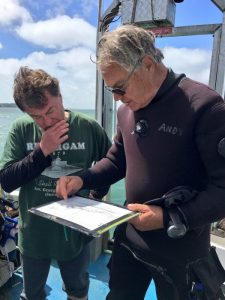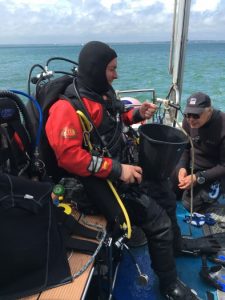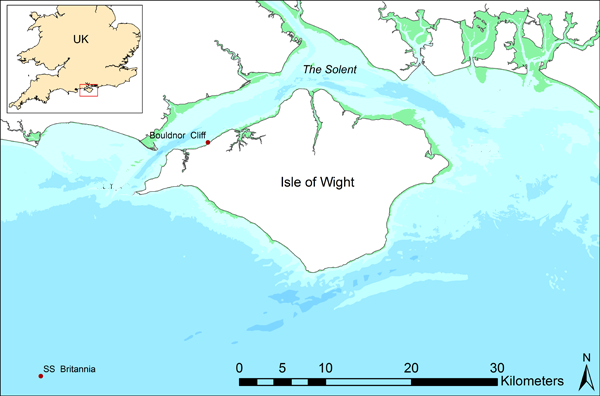
Just off the Isle of Wight is the site of Bouldnor Cliff. Bouldnor Cliff was a Mesolithic settlement, dating to 8,000 years ago. The finds from this site include worked timber and flints, and show that the inhabitants were using technology that was 2,000 years more advanced than expected in a site of this age!
The Mesolithic site is about eleven metres below the surface, and is part of the Solent Maritime Special Area of Conservation. Sadly, the tides of the Solent are eroding the site. More material is constantly being exposed, and subsequently is being threatened. The Maritime Archaeology Trust is working hard to monitor the site’s condition, and to recover material that is coming under threat.
The MAT is carrying out dives to create a record of the site, to document any changes that are taking place, and any exposed material. It is important to make frequent records of the site, and the plan is to use photogrammetry to create a 3D model. Divers first make a ‘pre-disturbance survey’, in order to ensure that the site is properly catalogued before making and changes or disturbing anything. Once the researchers are confident that there is a good record of the site and its contents, they are able to examine and rescue artefacts, and bring them to the surface for further study. These can be compared with the plan, in order to make note of where the artefacts were find, and piece together the site: a bit like putting together a big puzzle.
The divers set up a baseline at the site, in order to carry out the recording. A photographic survey was undertaken, to record the newly exposed features and document the site in its current condition, before any further work.
The first thing seen by the divers as they approached the site was some newly exposed timber, protruding from the bank. This timber was not visible last year, and has been revealed by the erosion. It appeared to have been worked, and looks like it may even be the remains of a platform. Later dives will aim to further study these timbers, and rescue them.
A later dive revealed a fellow archaeologist digging at Bouldnor Cliff: a lobster, with a collection of worked flints outside his burrow. Lobsters are frequent visitors to the site, and often turn up flints such as these. With the lobster’s help, the next dive recovered five small worked flints, and they were brought to the surface and inspected for the first time in 8,000 years.
The first day was a grand success, with four dives in total. The last of these dives included two new visitors; volunteers from Egypt who had come to see the site and assist in the photogrammetry. They were very impressed with what they saw, and can’t wait to return to the site and continue their study. The work at Bouldnor Cliff will continue, to ensure that the site is safe, any threatened material is recovered, and that we learn everything we can from this exciting site.
[huge_it_video_player id=”2″]



 Another day on Bouldnor Cliff reveals another exciting discovery. Garry Momber took part in the day’s first dive, and began to clear away some of the layer of mud covering the site. Underneath this mud he found a series of planks lying parallel to each other. Further dives will include more work on this potential platform, so the archaeologists can try to interpret the feature and its purpose. Yesterday, a diver found and recovered a small piece of flat, pointed timber that may turn out to be the end of a plank. Garry also recovered a small piece of wood, demonstrating the excellent preservation on this site. It is still possible to find organic material that is over 8,000 years old!
Another day on Bouldnor Cliff reveals another exciting discovery. Garry Momber took part in the day’s first dive, and began to clear away some of the layer of mud covering the site. Underneath this mud he found a series of planks lying parallel to each other. Further dives will include more work on this potential platform, so the archaeologists can try to interpret the feature and its purpose. Yesterday, a diver found and recovered a small piece of flat, pointed timber that may turn out to be the end of a plank. Garry also recovered a small piece of wood, demonstrating the excellent preservation on this site. It is still possible to find organic material that is over 8,000 years old! Miguel, Ziad, and Mohamed are still hard at work on the photogrammetric work. Miguel has been acting as underwater photographer, taking pictures of Garry at work and using a 6m x 2m grid to take photos to create a photogrammetric model of the site and some of the exposed timbers. Ziad and Mohamed are doing similar work, both with and without photogrammetric targets. The divers are working hard to ensure they don’t damage any of the exposed timbers as they do their work, and are being careful where they use targets. In places where the timber is fragile, it may be better to work without them. Eventually, the hundreds of photos taken will be combined together. They will be used to create a 3D model of the Mesolithic site, which can be manipulated and interpreted, and used for further study.
Miguel, Ziad, and Mohamed are still hard at work on the photogrammetric work. Miguel has been acting as underwater photographer, taking pictures of Garry at work and using a 6m x 2m grid to take photos to create a photogrammetric model of the site and some of the exposed timbers. Ziad and Mohamed are doing similar work, both with and without photogrammetric targets. The divers are working hard to ensure they don’t damage any of the exposed timbers as they do their work, and are being careful where they use targets. In places where the timber is fragile, it may be better to work without them. Eventually, the hundreds of photos taken will be combined together. They will be used to create a 3D model of the Mesolithic site, which can be manipulated and interpreted, and used for further study.

